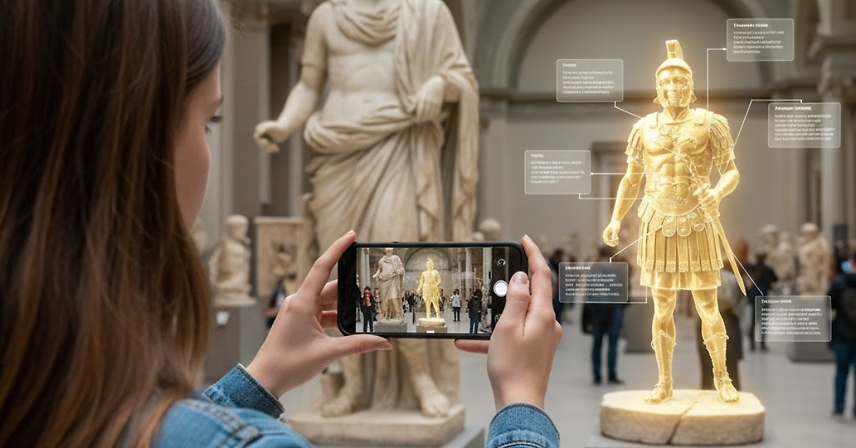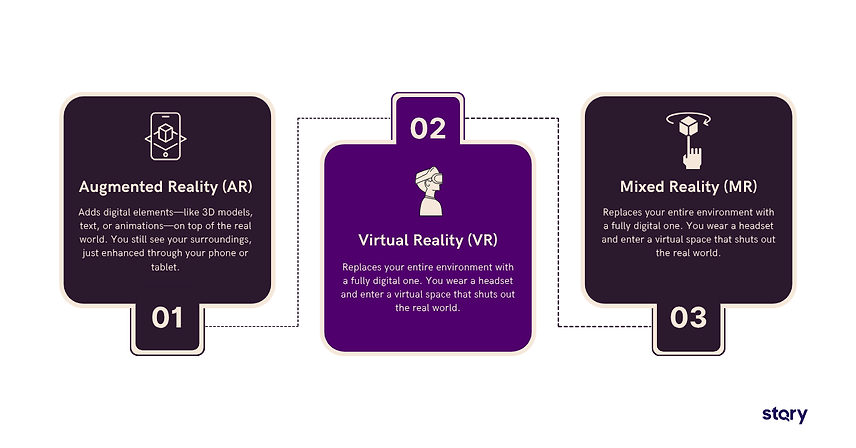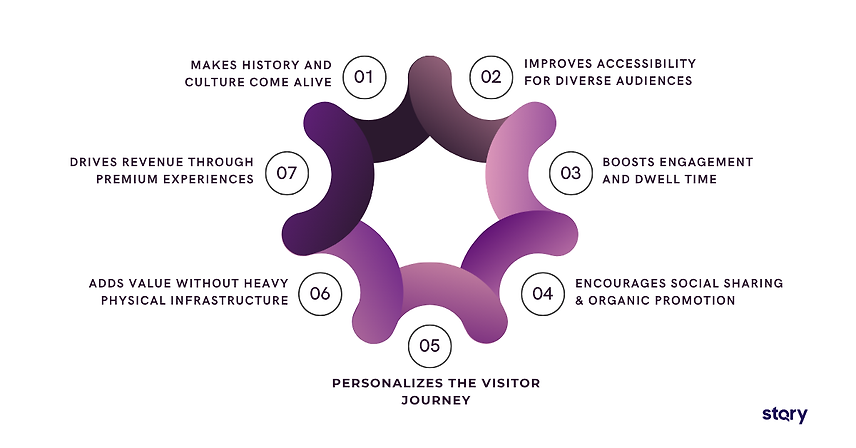
Forget passive sightseeing and dull guidebooks. A revolution is happening in the world of travel, transforming visitor experiences from a simple look-and-see into an immersive, interactive adventure.
We're talking about Augmented Reality (AR), the technology that overlays digital information onto the real world you see through your smartphone or specialized glasses.
This isn't just a futuristic fantasy. It's here, and it's rapidly reshaping tourism.
With the global mobile AR market projected to surge from $21 billion in 2023 to $36.2 billion by 2026 according to Statista, it’s clear that this blended reality is becoming the new normal for explorers everywhere.
What is Augmented Reality?

Augmented reality (AR) enhances your real-world surroundings by adding digital layers on top of them. You're still looking at the actual street, museum, or landmark in front of you. AR just adds interactive elements like 3D models, animations, or information overlays.
This makes AR different from virtual reality (VR). VR replaces your entire view with a completely digital environment, usually through a headset that blocks out the real world.
AR, on the other hand, works through your smartphone or tablet screen. You point your camera at something real, and digital content appears alongside it.
Bridging the gap between the two is Mixed Reality (MR). MR is the next evolution, where digital and real-world objects don't just coexist, but actually interact with each other in real-time.
For instance, you could see a virtual ancient warrior walk behind a real pillar. This works because advanced technology understands the exact layout of the room. You could even turn a digital dial to change the color of a real exhibit light.
The term Extended Reality (XR) is the umbrella term that covers all these immersive technologies: AR, VR, and MR.
What are the Benefits of Augmented Reality in Tourism?
AR is transforming the tourism industry by blending digital content with real-world environments. Here are some of the key benefits it brings to visitors and destinations alike.

Makes History and Culture Come Alive
Static plaques and faded photos can only tell part of the story. AR changes that by layering vivid visuals and storytelling directly onto real-world settings
Instead of trying to picture what ruins once looked like, visitors can see detailed 3D reconstructions right where they stand.
With AR, artifacts no longer sit silently behind glass. They come alive with short animations that reveal how they were used and who once owned them. These interactive layers build a stronger emotional connection than traditional signage ever could.
When a medieval castle appears in its full glory as you stand in its courtyard, history no longer feels distant—it feels alive.
Improves Accessibility for Diverse Audiences
Language barriers and accessibility challenges have always limited who can fully enjoy tourist destinations. AR offers practical solutions to both problems.
Visitors can point their phones at objects or locations to trigger instant translations, audio guides, or captions in their preferred language. This means a family from Japan gets the same rich experience at a French museum as local visitors.
People with hearing or vision impairments can also access information through multiple sensory channels.
As Meta notes, "AR and VR have the potential to break down mental, physical and societal barriers and create the space for meaningful connection."
The technology doesn't just add features—it levels the playing field.
Boosts Engagement and Dwell Time
Passive sightseeing gets old fast. Augmented reality turns observation into participation.
Interactive overlays transform ordinary tours into hands-on adventures. Scavenger hunts lead visitors through neighborhoods, while AR games unlock hidden stories at every stop.
Even simple object recognition can trigger animations that surprise and delight. This level of interactivity makes a real difference.
According to Threekit, AR product experiences are 200% more engaging, delivering twice the interaction of their non-AR counterparts.
When visitors are actively involved, they stay longer, explore more deeply, and are far more likely to share their experience with others.
Encourages Social Sharing & Organic Promotion
Every destination needs marketing, but with augmented reality, that marketing often creates itself.
Branded AR filters let visitors virtually wear cultural icons or pose with famous landmarks. What starts as a fun photo quickly turns into shareable content that spreads across social media.
Each post becomes authentic word-of-mouth marketing, reaching audiences that traditional ads often can’t. Because it’s user-generated, the impact runs deeper. People trust recommendations from friends far more than paid promotions. And the data supports it.
According to Snapchat, nearly half of Gen Z users feel more connected to brands through AR lenses and filters. That sense of connection builds destination loyalty and inspires future visits.
Personalizes the Visitor Journey
Not everyone wants the same experience. Families with kids want games and interactive fun. History buffs want detailed reconstructions and deep context. Art lovers want information about techniques and influences.
AR adapts to all of them. The same physical space can offer multiple digital layers based on visitor preferences. Parents unlock treasure hunts for their children while simultaneously accessing architectural details for themselves.
This flexibility means each visitor gets a customized tour that matches their interests.
Adds Value without Heavy Physical Infrastructure
Building new exhibits costs money. Physical installations require maintenance. Heritage sites face strict preservation requirements that limit what can be added or changed.
AR sidesteps these constraints entirely. Digital layers don't require construction permits or disrupt historical integrity.
You can add elaborate storytelling experiences to existing spaces without hammering a single nail. This approach reduces costs while preserving the authentic character of locations.
It's particularly valuable for outdoor heritage trails or protected archaeological sites where physical modifications aren't possible.
Drives Revenue Through Premium Experiences
Destinations can monetize AR tours through app purchases, premium content unlocks, or bundled ticket upgrades.
Visitors who want basic access can use free features, while those seeking deeper experiences pay for exclusive digital content. This tiered approach creates new income streams without alienating budget-conscious travelers.
For many tourism operators, AR has become both an attraction enhancer and a profit center.
Examples of AR in Tourism That Drive Results
Here are several examples of how Augmented Reality is successfully used by destinations and businesses to drive measurable results
1. Object Overlays & Interactive Storytelling
The most straightforward AR application layers 3D models onto real-world objects or locations. Museums use this to show how artifacts were originally used. Heritage trails reconstruct buildings that no longer exist.
Take the SA National Parks Tours app as an example. In South Australia’s parks, visitors can use AR to view Glenthorne House, a grand structure that once hosted picnics, jubilees, and even tug-of-war matches.
The house burned down in 1932, but AR now restores its architecture and lively history.
Standing on the original site, visitors see its walls and windows appear over the empty landscape, bringing the past back to life.
2. AR Photo Filters & Social Sharing
Branded filters turn every visitor into a content creator. Tourists can virtually wear traditional clothing, pose with landmark icons, or add cultural elements to their selfies.
The viral potential here is significant. Each shared photo or video introduces the destination to hundreds of new potential visitors.
What starts as playful fun becomes authentic, organic promotion that reaches audiences traditional marketing can't touch.
3. Web-Based AR
Not every visitor wants to download a dedicated app. Web-based AR removes that barrier entirely.
Platforms like 8th Wall, MyWebAR, Zappar, and Unity WebAR make it easy to deliver AR experiences through simple web links. Visitors scan a QR code, their browser launches, and AR overlays appear without any app download.
This approach dramatically lowers the entry barrier and makes AR accessible to more people.
It's also cost-effective for destinations testing AR for the first time. You can launch pilot projects without major infrastructure investment.
4. AR Model Overlays
Camera-based AR experiences work well when you already have 3D content created. You host the models, provide access links, and visitors can view artifacts or products in immersive 3D.
The Liberty Trail SC demonstrates this approach effectively. This self-guided tour connects Revolutionary War battlefields and historic sites across South Carolina.
One AR feature showcases a 250-year-old Spanish Dollar—a "Piece of 8"—excavated near Fort Fair Lawn. Visitors view the coin through augmented reality and learn about its significance in colonial commerce.
The coin sits in a collection somewhere, but AR makes it accessible to thousands of people standing at the excavation site.
5. Fully Integrated AR Tours & Advanced Experiences
Advanced AR setups often need powerful platforms like STQRY, skilled developers, and reliable hosting systems. In return, they unlock storytelling possibilities that simpler tools can’t achieve.
With these systems, multi-stop self-guided tours with AR integration can guide visitors across entire destinations. Gamified challenges encourage exploration and reward curiosity. Interactive educational layers even adapt to each visitor’s choices in real time.
While these experiences take more planning and resources, they create the most immersive and memorable interactions.
FAQs
Is AR the future of tourism?
Yes. Augmented reality is shaping the future of tourism by enhancing, not replacing, traditional experiences. It adds digital storytelling and interactivity that make visits more engaging while keeping the authenticity of the destination intact.
Is augmented reality the same as AI?
No. AR, or augmented reality, overlays digital content onto the real world, while AI, or artificial intelligence, powers how that content behaves. AI can recognize objects or personalize AR experiences, but AR itself focuses on visual enhancement, not intelligence.
What is needed for augmented reality in tourism?
To use AR, visitors only need a smartphone or tablet with a camera and AR support. Destinations need 3D models or overlays, an AR platform to host content, and markers or QR codes to trigger experiences on-site.
Power Your AR Tourism Experiences with STQRY
Creating engaging AR experiences doesn’t have to mean starting from scratch or dealing with complex development. STQRY gives tourism operators an easy-to-use platform built specifically for delivering interactive and memorable visitor experiences.
Whether you want to add simple web-based AR overlays or design full multi-stop self-guided tours, STQRY provides the tools and support to bring your ideas to life. We take care of the technical side so you can focus on storytelling and visitor engagement.
From historic landmarks to modern attractions, STQRY helps destinations reimagine how visitors connect with their surroundings.
Ready to see what AR can do for your destination?